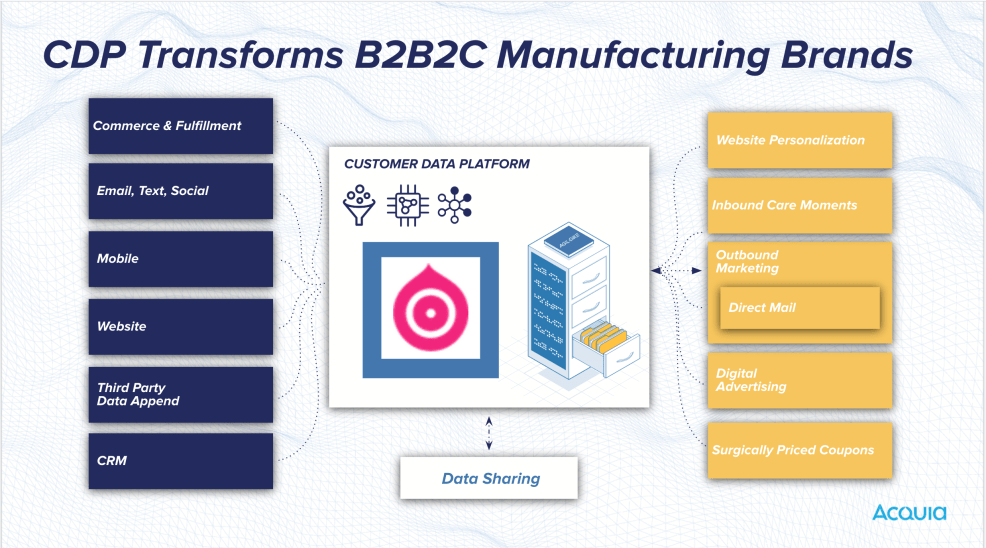
How Manufacturers Use Data and Content to Modernize Operations and Connect With Customers

Has COVID re-framed the way your manufacturing brand interacts with customers? Has it exposed supply chain inefficiencies and put more volumetric pressure to support historically retail-only activities? For many manufacturing brands, new opportunities have emerged to accelerate their digital experiences.
Increasingly, B2B2C manufacturers of CPG, fashion, equipment and otherwise are realizing the enormous value of adopting a direct-to-consumer (D2C) strategy for their products. Instead of just generating prospective demand to be converted by legacy retail channels, manufacturers are increasingly asking digital experience leaders like Acquia to help own and capitalize customer relationships with off-domain acquisition, simple commerce conversion moments, ongoing nurture efforts and even charging third-parties programmatic access to their audience.
As workers face new risks across the operation, manufacturing brands are investing in digital technology to transform their business operations and continuously improve efficiency and tighten the feedback loop between rapidly changing consumer behaviors.
Continuous Improvement within a Digital Framework
The global pandemic has afforded your brand a once-a-century (hopefully) opportunity by de-emphasizing legacy brick-and-mortar retail experiences in favor of digital moments supported by distribution providers. Now is the best time to grab value by reimagining experiences your customers will love.
Manufacturing brands, especially struggle with getting digital transformation traction, though. Worse yet, they cede their most valuable asset, their customer portfolio, to third-party digital marketplaces like Amazon or Alibaba.
Brands are often overwhelmed by the promise of an omnichannel, direct-to-consumer future. Leading brands, however, prioritize use-cases by value and continuously deliver incremental improvement within a solution framework.
Stakeholders need to be dynamic, processes need to be agile and tools need to be open to incrementally realize value over time. So where should manufacturing brands begin? Assuming your brand already has the right people or partners in place, let’s start with customer data.

Direct-to-Consumer: Know Your Customers
Customer profile and transaction data are your brand’s most valuable assets, and just like the D2C gold-standards Facebook, Amazon, Apple, Netflix and Google, your manufacturing brand needs to get customer data right.
Although traditional sales channels have historically done a poor job of capitalizing, legacy retailers have significantly improved their data-driven customer experience (CX). Worse yet, new commerce marketplace channels, like Amazon or Alibaba, make absolutely no mistake; your margins are their business, and they use their superior CX as differentiation to commandeer and hold hostage your most valuable asset: your customers. As COVID has made clear, owning customer data is your brand’s revenue lifeline. When Amazon cuts you out as a replenishment supplier, the quality of your owned D2C channels determines whether your brand thrives or withers.
Third-party commerce experiences and retailers will capitalize these customer data by
- charging other entities paid access to its audience, including your brand!
- cross-/up-/next-selling products beyond your brand’s offerings and informed by their AI-powered recommendations, not yours.
- dropping prices over time as these commerce audiences perceive none of your brand value-add for commoditized brand lifestyle-related products (RIP Toys R’ Us, et al).
How long before Amazon offers your customers a subscription based on your brand’s target demographic lifestyle: Amazon Healthcare, Groceries, etc? Will your brand be able to compete with a broad set of lifestyle oriented offerings beyond your own manufactured products?
Customer data platforms (CDPs) have become foundational for B2B2C manufacturing brands, and COVID has accelerated adoption. CDPs are packaged software that create persistent, unified customer records and actionable insights accessible by humans and other systems.
CDPs take the facts about your customers and deliver actionable truths. Realize iteratively compounding positive value by thoughtfully adding data sources and activation channels to your CDP to achieve multi-channel goals as your brand progresses to its omnichannel vision over time. These predictive analytics are used to scalably increase revenue with improved customer lifetime values and acquisition, decrease cost with optimized media spend and mitigate financial and existential risks by delighting your customers as a D2C brand.
In the coming decade, give your brand a chance to ascend to a lifestyle brand with its own marketplace and charge complementary brands access to your owned audience.
Digitizing Your Industrial Operations
Manufacturers now have an opportunity to rethink manufacturing operations beyond the website. Too often, however, our manufacturing customers are so occupied running their website engine, that they neglect the value of recent digital experience platform (DXP) advancements.
Increasing manufacturing operational efficiency no longer just means a better bottom line and mitigated operational risk, it also means a safer workplace environment and reduced risk of litigation.
What would it mean to your business if your brand converted just one painful manufacturing floor paper-based process into a mobile one with supporting, contextual, workflow moment, knowledge base rich media? Or if your brand navigated complicated internal workflows with email, text or mobile push notification automation?
What would it mean for your business and operations managers if manufacturing process tracking were consolidated into mobile dashboarding powered by logistics data? And ultimately, what if logistics were directly tied to your front-office CX and commerce fulfillment workflows via your CDP?
With DXP templates, low-code tools and site and campaign factory frameworks, you can do it, do it iteratively for incremental value and do it faster than ever across device types.
Don’t be overwhelmed or afraid. Be smart and strategically attack your B2B2C manufacturing opportunities.
Learn more about how Acquia’s open digital experience platform helps manufacturing brands connect with customers and optimize business operations.

